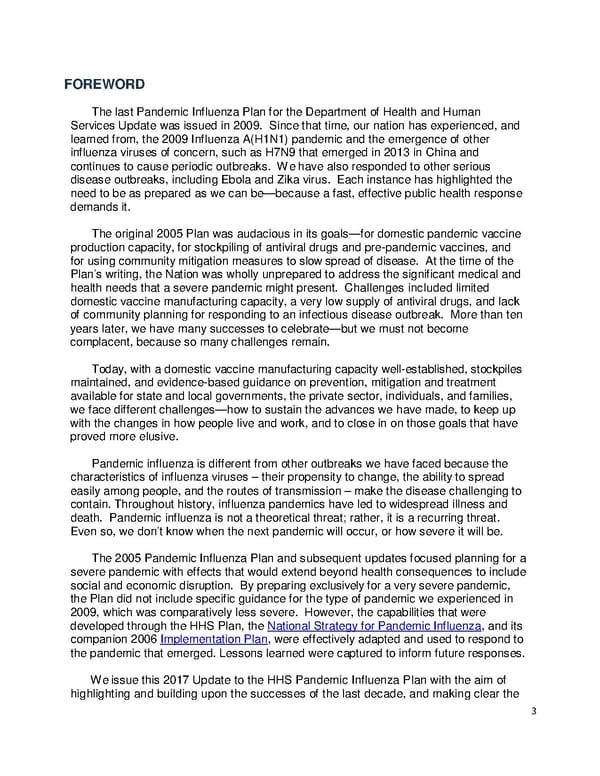FOREWORD The last Pandemic Influenza Plan for the Department of Health and Human Services Update was issued in 2009. Since that time, our nation has experienced, and learned from, the 2009 Influenza A(H1N1) pandemic and the emergence of other influenza viruses of concern, such as H7N9 that emerged in 2013 in China and continues to cause periodic outbreaks. We have also responded to other serious disease outbreaks, including Ebola and Zika virus. Each instance has highlighted the need to be as prepared as we can be—because a fast, effective public health response demands it. The original 2005 Plan was audacious in its goals—for domestic pandemic vaccine production capacity, for stockpiling of antiviral drugs and pre-pandemic vaccines, and for using community mitigation measures to slow spread of disease. At the time of the Plan’s writing, the Nation was wholly unprepared to address the significant medical and health needs that a severe pandemic might present. Challenges included limited domestic vaccine manufacturing capacity, a very low supply of antiviral drugs, and lack of community planning for responding to an infectious disease outbreak. More than ten years later, we have many successes to celebrate—but we must not become complacent, because so many challenges remain. Today, with a domestic vaccine manufacturing capacity well-established, stockpiles maintained, and evidence-based guidance on prevention, mitigation and treatment available for state and local governments, the private sector, individuals, and families, we face different challenges—how to sustain the advances we have made, to keep up with the changes in how people live and work, and to close in on those goals that have proved more elusive. Pandemic influenza is different from other outbreaks we have faced because the characteristics of influenza viruses – their propensity to change, the ability to spread easily among people, and the routes of transmission – make the disease challenging to contain. Throughout history, influenza pandemics have led to widespread illness and death. Pandemic influenza is not a theoretical threat; rather, it is a recurring threat. Even so, we don’t know when the next pandemic will occur, or how severe it will be. The 2005 Pandemic Influenza Plan and subsequent updates focused planning for a severe pandemic with effects that would extend beyond health consequences to include social and economic disruption. By preparing exclusively for a very severe pandemic, the Plan did not include specific guidance for the type of pandemic we experienced in 2009, which was comparatively less severe. However, the capabilities that were developed through the HHS Plan, the National Strategy for Pandemic Influenza, and its companion 2006 Implementation Plan, were effectively adapted and used to respond to the pandemic that emerged. Lessons learned were captured to inform future responses. We issue this 2017 Update to the HHS Pandemic Influenza Plan with the aim of highlighting and building upon the successes of the last decade, and making clear the 3
 Pandemic Influenza Plan Page 2 Page 4
Pandemic Influenza Plan Page 2 Page 4